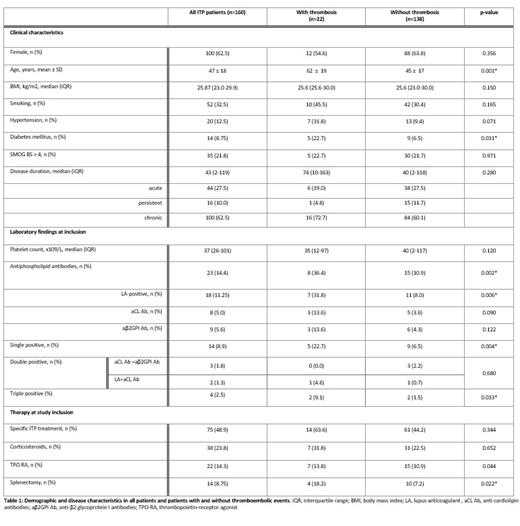Background: Patients with primary Immune thrombocytopenia (ITP) have an increased risk of bleeding but paradoxically also an increased thromboembolic risk.
Aim: The aim of this study was to prospectively assess the occurrence and risk factors of symptomatic venous thrombotic events (VTE) and arterial thrombotic events (ATE) in patients with primary immune thrombocytopenia.
Methods: This study included 160 adult patients with primary ITP enrolled in the Vienna ITP Biobank, a dual-center cohort study (Medical University of Vienna; Hanusch Hospital) that prospectively collects data of patients diagnosed with primary ITP (EC 1843/2016). Patients with primary ITP and a history of VTE or ATE, as well as those who experienced new or recurrent thrombotic events (TE) during the observation period, were categorized into two groups: with-thrombosis and without-thrombosis. The patient characteristics were compared using a chi-squared or Fisher's exact test for categorical and for numerical data were performed using the Mann-Whitney-U-test. The association between clinical risk factors and thrombosis were performed by univariable analyses using logistic regression model.
Results: Of the 160 ITP patients (Table 1), 22 patients (13.8%) had 25 documented ATE or VTE. These events consisted of 11 ATE (44%), including 7 acute myocardial infarctions, 3 cerebral vascular events (stroke or TIA), and 1 peripheral artery thrombosis, and 14 (65%) venous events (1 superficial vein thrombosis, 7 deep vein thromboses, 2 deep vein thromboses with pulmonary embolism and 4 cases of isolated pulmonary embolism). 8 (36.4%) of 22 patients had a history of thrombosis. 17 (77.3%) patients experienced TE during the median observation period of 2.2 (1-3) years. Of them 14 (82.4%) patients had a new TE and 3 (17.6%) recurrent TE. The cumulative 1- and 5-year incidence of TE accounting for competing mortality were 1.9 % and 5.0%. Four (18.2%) patients with thrombosis died during the follow-up period. The cause of death was unclear for three patients, while one patient died from pulmonary embolism.
Patients with thrombosis were significantly older (p=0.001) and had more comorbidities than patients without thrombosis (Table 1). There was no difference in the platelet counts between the groups. Antiphospholipid antibodies were present in 14.4% of the patients, and their prevalence was higher in the thrombosis group (p=0.002). In the univariable regression analysis, factors such as older age ≥75 years (OR 1.06; 95%CI 1.03-1.09, p=0.001) diabetes mellitus (OR 4.02; 95%CI 1.20-13.413, p=0.024), presence of antiphospholipid antibodies (OR 6.04; 95%CI 2.01-25.63, p=0.003), particularly lupus anticoagulant positivity (OR 5.39 95%CI 1.8-13.0, p=0.002), and splenectomy (OR 3.07; 95%CI 1.13-12.63, p=0.031) were significantly associated with a higher risk of arterial and venous thrombotic events among ITP patients. Body-Mas-Index, disease duration, tobacco use, hypertension, and use of corticosteroids or thrombopoietin receptor agonist (TPO-RA) were not associated with increased risk of VTE and ATE.
Conclusion: We observed a high rate of ATE and VTE in our patients with primary ITP. Additionally, ITP patients commonly present with typical risk factors for thrombotic events, suggesting a strict management of cardiovascular risk factors. Close monitoring and tailored treatment strategies should minimize the risk of bleeding and thrombotic events.
Disclosures
Mehic:CSL Behring: Honoraria. Ay:Bayer, CSL Behring, Novo Nordisk, Pfizer, Roche, Sobi and Takeda: Honoraria.


